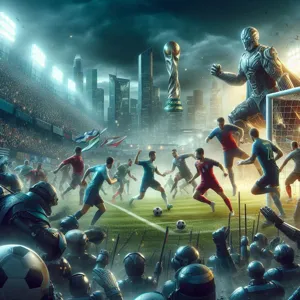As the world eagerly anticipates the next installment of the FIFA World Cup, the excitement is palpable.
Yet, amid the fervor of fans and the thrill of competition, a critical question emerges: Are we witnessing the last hurrah of the traditional format? The World Cup has long been revered as the pinnacle of footballing excellence, showcasing the world’s best teams and players in a month-long celebration of sport. However, as the landscape of global football evolves, driven by changing fan demographics, advancements in technology, and calls for inclusivity, it may be time to reimagine this storied tournament. In this blog post, we will explore the potential benefits and challenges of a new format for the World Cup, considering innovative ideas that could enhance the tournament’s excitement, accessibility, and fairness. Join us as we delve into a discussion that could redefine the future of this iconic event, ensuring it remains a celebration of the beautiful game for generations to come.
1. Introduction: The Evolution of the World Cup

The FIFA World Cup, a grand spectacle that unites nations and ignites passions, has undergone a remarkable evolution since its inception in 1930. What began as a modest tournament featuring just 13 teams has transformed into an unparalleled global event, capturing the hearts of millions and showcasing the pinnacle of football talent. As we reflect on the rich history of the World Cup, it’s essential to acknowledge the ways in which the tournament has adapted to the changing landscape of the sport and the world at large.
From the early days when matches were played in front of a few thousand spectators to the present, where stadiums brim with tens of thousands and TV screens beam the action into living rooms across continents, the World Cup has consistently pushed boundaries. The introduction of new technologies, such as VAR and goal-line technology, has revolutionized how the game is played and officiated, while the expansion of the tournament format has allowed for greater inclusivity and representation from nations around the globe.
However, as we stand on the brink of a new era in football, questions arise about whether the traditional structure of the World Cup still serves its purpose or if it’s time for a bold reinvention. With emerging trends, including the rise of women’s football, the increasing influence of digital media, and the evolving expectations of fans, the conversation about the World Cup’s format is more pertinent than ever. Can we reimagine this iconic tournament in a way that not only honors its storied past but also embraces the future of the game? In this exploration, we’ll delve into the potential pathways for innovation, examining how a new format might enhance the World Cup experience for players and fans alike.
2. The Historical Significance of the World Cup
The FIFA World Cup is not just a tournament; it is a global phenomenon steeped in rich history and cultural significance. Since its inception in 1930, this prestigious event has transcended mere athletic competition, becoming a symbol of national pride and unity for countries across the globe. The World Cup has witnessed unforgettable moments: from Diego Maradona’s “Hand of God” goal in 1986 to the dramatic penalty shootout that crowned Italy champions in 1994. Each tournament has left an indelible mark on the hearts of fans, weaving stories that resonate far beyond the pitch.
The historical significance of the World Cup extends to its role in shaping the modern game of football. Over the decades, it has evolved from a modest gathering of 13 teams to an expansive celebration featuring 48 nations, reflecting the growing popularity and commercial appeal of football worldwide. The event has also served as a platform for social change, highlighting issues such as inequality and the power of sport to bridge cultural divides.
Moreover, the World Cup has become a cultural touchstone, influencing music, art, and even fashion. Major international events often see an influx of creative expressions, from vibrant street murals to anthems that capture the spirit of the tournament. Countries invest heavily in showcasing their unique identities, turning the World Cup into a vibrant tapestry of traditions and innovations.
As we reflect on the historical significance of the World Cup, it becomes clear that it is more than just a sporting event; it is a celebration of human achievement and a mirror of societal evolution. However, as we stand on the brink of a new era, it begs the question: Is it time to rethink the format of this beloved tournament to ensure it continues to resonate with future generations?
3. Current Format Overview: Strengths and Weaknesses

The current format of the FIFA World Cup has remained relatively unchanged for decades, fostering a sense of tradition and continuity within the sport. Comprised of 32 national teams, the tournament unfolds over a month-long period, culminating in a grand finale that captures the attention of millions around the globe. At first glance, this structure has undeniable strengths—namely, its ability to generate excitement and showcase the world’s best talent on one of the largest stages in sports.
One of the key strengths of the current format is its inclusivity. With teams from various continents competing, the tournament fosters a spirit of global unity, allowing fans from diverse backgrounds to rally behind their nations. The knockout stages create nail-biting tension, where every match can result in triumph or heartbreak, adding to the tournament’s allure. Additionally, the long-standing tradition of the World Cup creates a sense of nostalgia and anticipation, drawing in both new and seasoned fans alike.
However, this format is not without its weaknesses. The limited number of teams can lead to a lack of representation from emerging footballing nations, which can stifle the growth of the sport in regions where it is gaining popularity. Moreover, the group stage can sometimes result in mismatched games where stronger teams dominate weaker ones, leading to predictable outcomes and diminished excitement. Additionally, the lengthy tournament can take a toll on players, with fatigue and injuries potentially affecting performance levels.
As the global football landscape evolves, it raises the question: is it time to rethink the World Cup format? By examining its strengths and weaknesses, we can begin to consider alternatives that would not only enhance the viewer experience but also ensure the tournament remains a true celebration of football for years to come.
4. Globalization and Its Impact on Football
Globalization has transformed the landscape of football, influencing everything from player transfers to fan engagement, and it has left an indelible mark on the World Cup itself. As borders blur and cultures intertwine, the beautiful game has evolved into a truly global phenomenon, drawing in diverse audiences and an array of playing styles from around the world. This interconnectedness has both enriched the sport and posed challenges that merit serious consideration when reimagining the World Cup format.
One of the most notable impacts of globalization is the rise of international player transfers. Talented athletes from all corners of the globe now find opportunities to play in leagues far from home, creating a melting pot of skills and strategies. This infusion of diverse influences not only elevates the standard of play but also enhances the World Cup’s appeal, as fans are eager to see how their local heroes perform on the world stage. However, this increased international competition raises questions about national identity and representation. Are we witnessing the dilution of traditional football cultures in favor of a more homogenized global style?
Moreover, globalization has expanded the reach of football fandom. With the advent of digital technology and social media, fans can now follow their favorite teams and players from anywhere in the world. This connectivity has fostered a passionate, engaged global audience, but it also raises concerns about the sustainability of local fan bases and the economic disparities that can arise from wealthier nations dominating the sport. As the World Cup evolves, it will be crucial to ensure that the tournament remains inclusive and accessible, celebrating the rich tapestry of football culture while adapting to the realities of a globalized world.
In this context, the format of the World Cup must be reevaluated. Should it continue to favor traditional powerhouses, or is it time to embrace a more egalitarian approach that allows for greater representation from emerging football nations? As we ponder the future of this iconic tournament, we must recognize that globalization is not just a force to be reckoned with; it is an opportunity to redefine and expand the very essence of the World Cup, making it a celebration of the game that resonates with fans from every corner of the globe.
5. Fan Engagement: The Need for a Fresh Approach

In an era where fan engagement is paramount, the traditional World Cup format may no longer suffice to captivate the modern audience. Spectators today crave interactive and immersive experiences that go beyond the thrill of watching matches. As we reimagine the glory of this prestigious tournament, it becomes essential to explore innovative strategies that can deepen the connection between fans and the event.
Imagine a World Cup where fans have a voice in the tournament’s activities, from voting on match locations to selecting the official mascot. Integrating technology, such as augmented reality (AR) and virtual reality (VR), could revolutionize how fans experience the games. Virtual stadium tours, behind-the-scenes access, and interactive fan zones could enhance the atmosphere, making supporters feel truly part of the action, even if they are miles away from the stadium.
Moreover, leveraging social media platforms to create real-time engagement can amplify the excitement surrounding each match. Live Q&A sessions with players, interactive polls during games, and fan-generated content competitions can foster a sense of community, transforming passive viewers into active participants. By creating a bridge between players and fans through platforms like Instagram and Twitter, the World Cup can harness the power of storytelling and personal connection.
Additionally, addressing diverse fan demographics is critical. Tailoring experiences and content to different cultures and regions can make the event feel more inclusive, ensuring that everyone feels represented and valued. This could include localized celebrations, multilingual commentary, and culturally resonant marketing campaigns.
As we contemplate a new format for the World Cup, embracing fan engagement as a core component is essential. By prioritizing these fresh approaches, we can ensure that the tournament not only retains its historical significance but also evolves to meet the changing expectations of a global fanbase. After all, the heart of any sporting event lies in its supporters, and creating memorable, engaging experiences will undoubtedly keep the spirit of the World Cup alive for generations to come.
6. Alternative Tournament Formats: A Comparative Analysis
As the world of sports evolves, so too must the structures that govern them. The World Cup, with its rich history and global appeal, stands at a crossroads, prompting a critical examination of alternative tournament formats that could breathe new life into this prestigious event. In this section, we delve into various alternative formats that have been proposed or successfully implemented in other sports, comparing their potential benefits and drawbacks.
One of the most discussed alternatives is the introduction of a league-style format. This approach would see teams playing each other in a round-robin format before progressing to a knockout stage. Advocates argue that this format would provide a fairer assessment of team strength, allowing the best teams to emerge based on consistent performance rather than a single-elimination match. Such a structure would also generate excitement over a longer period, keeping fans engaged throughout the tournament.
In contrast, the traditional knockout format, which has been the backbone of the World Cup, offers a thrilling sense of urgency and unpredictability. Each match becomes a pivotal moment, where the stakes are high and surprises can happen at any time. This unpredictability is a hallmark of the tournament’s charm, drawing in millions of viewers who relish the drama of sudden-death scenarios. However, this format can also lead to the early exit of strong teams, prompting debates about fairness and representation.
Another innovative suggestion involves regional tournaments leading up to the World Cup. This would see nations competing in smaller, localized championships to qualify for the main event. Similar to the UEFA European Championship, this format could foster fierce rivalries and enhance the competitive spirit, while also making it easier for smaller nations to participate and gain exposure.
Finally, the idea of expanding the number of participating teams has gained traction, particularly in light of FIFA’s decision to increase spots for the World Cup. While a larger pool of teams enhances diversity and inclusivity, it also raises questions about the quality of play and the logistics of organizing matches across various locations.
In conclusion, exploring alternative tournament formats for the World Cup presents both exciting possibilities and complex challenges. Whether it’s adopting a league-style structure, enhancing regional qualifications, or expanding team participation, each option offers unique opportunities to reimagine glory on the world stage. As we ponder these changes, it’s crucial to balance tradition with innovation, ensuring that the essence of the World Cup remains intact while meeting the evolving expectations of fans and players alike.
7. The Role of Technology in Modernizing the World Cup

As we stand on the brink of a new era in sports, the role of technology in modernizing the World Cup cannot be overstated. The beautiful game has always been a spectacle, but the way we consume it is evolving rapidly, driven by advancements that enhance the viewing experience, improve player performance, and streamline operations.
Imagine a World Cup where every match is infused with augmented reality, allowing fans to access real-time statistics and player information simply by pointing their devices at the screen or the pitch. This kind of engagement not only captivates audiences but also deepens their understanding of the game. Enhanced broadcasts with multiple camera angles, drone footage, and 360-degree views can transport viewers right into the heart of the action, making them feel as if they’re sitting in the stadium, even if they’re thousands of miles away.
Furthermore, technology plays a crucial role in ensuring fair play. With the introduction of Video Assistant Referee (VAR) systems, critical decisions can be reviewed with precision, minimizing human error and enhancing the integrity of the matches. However, the use of technology extends beyond the pitch. Data analytics and AI are becoming essential tools for coaches and teams, allowing them to analyze player performance, devise effective strategies, and even predict injury risks.
Social media platforms are also revolutionizing fan engagement. Real-time updates, interactive polls, and behind-the-scenes content can create a sense of community among fans, drawing them closer to the tournament. Brands can leverage this technology to create immersive marketing campaigns that resonate with the audience, building excitement and anticipation leading up to the event.
As we consider the future of the World Cup, it is clear that embracing technology is not just an option; it’s a necessity. By reimagining how we integrate these innovations, we can create a tournament that honors the rich history of the World Cup while also paving the way for a more inclusive, engaging, and thrilling experience for fans around the globe. The question remains: are we ready to embrace this digital transformation and redefine what it means to celebrate the world’s greatest football tournament?
8. Lessons from Other Sports: Successful Format Innovations
When considering a fresh approach to the World Cup, it’s essential to look beyond the realm of football and draw inspiration from other sports that have successfully redefined their tournament formats. These innovations not only enhanced viewer engagement but also increased participation and excitement among fans.
Take, for instance, the NBA’s decision to implement a play-in tournament for playoff spots. By introducing this format, the league has injected a thrilling layer of competition into the regular season’s final weeks, transforming the narrative for teams on the cusp of playoff contention. The added drama captivates fans, keeping them engaged right up to the last game. This approach could be mirrored in the World Cup by introducing a similar qualifying round that allows more nations to vie for a coveted place, thereby expanding the tournament’s inclusivity and creating new rivalries.
Another notable example comes from rugby with its Rugby World Cup. The tournament has evolved over the years, incorporating a round-robin format in the pool stages, which ensures that teams play multiple matches against different opponents. This not only amplifies the stakes as every game counts but also builds a narrative around each team’s journey, allowing fans to connect more deeply with the competition. A shift toward a round-robin format in the initial stages of the World Cup could offer fans a broader experience and a chance to see more matches featuring diverse teams.
Furthermore, the IPL (Indian Premier League) in cricket has mastered the art of creating an exhilarating tournament atmosphere. By adopting a shorter format with high-octane matches, the IPL has attracted a younger audience and generated immense viewership. The World Cup could consider introducing shorter, high-stakes matches or even mixed-format games that merge traditional and modern techniques, thus appealing to both loyal fans and newcomers.
As we contemplate the future of the World Cup, it’s clear that the potential for innovation is vast. By learning from other sports that have successfully navigated format changes, we can reimagine the World Cup in ways that foster excitement, encourage participation, and ultimately elevate the beautiful game to new heights. The challenge lies not just in reformatting but in ensuring that these changes resonate with the rich history and passion surrounding the tournament.
9. Player Welfare and Scheduling Considerations
As the world of football evolves, the demands on players have never been greater. With an increasingly packed schedule that includes international tournaments, club commitments, and domestic leagues, player welfare has become a pressing issue that cannot be overlooked in the discussion of World Cup formats.
The rigors of modern football place immense physical and mental strain on athletes, who must navigate not only the demands of performance but also the risks of injury. The traditional World Cup format, with its intense schedule and high-stakes matches, can exacerbate this pressure, leaving players vulnerable to burnout or fatigue. It is essential to consider whether a new structure could alleviate some of these burdens while still preserving the excitement and prestige of the tournament.
One potential avenue worth exploring is a more spaced-out tournament schedule, allowing players ample recovery time between matches. This could involve extending the tournament duration or adjusting the frequency of matches to ensure that athletes can perform at their best — both physically and mentally. Additionally, introducing measures such as rolling substitutions or limited match appearances for certain players could help manage workloads without compromising the competitive integrity of the event.
Moreover, the impact of scheduling conflicts must be addressed, particularly for clubs that want to retain their star players during vital league fixtures. A new World Cup format could incorporate better alignment with club seasons, ensuring that players are not torn between representing their country and fulfilling club obligations. This would not only support players’ welfare but also enhance the overall quality of the tournament, as athletes would be fresher and more prepared to compete at the highest level.
Ultimately, as we ponder the future of the World Cup, we must prioritize player welfare and scheduling considerations to create a format that honors the athletes who dedicate their lives to the sport. A reimagined tournament that respects their well-being could lead to a more thrilling and sustainable celebration of football for generations to come.
10. Stakeholder Perspectives: Fans, Players, and Coaches
When considering a new format for the World Cup, it’s crucial to engage with the voices that matter most: the fans, players, and coaches. Each group has unique perspectives and valuable insights that can shape the future of this beloved tournament.
**Fans** are the heartbeat of the World Cup, bringing passion, energy, and loyalty to the event. Their enthusiasm transcends borders, uniting nations in support of their teams. However, as the global landscape evolves, so do fans’ expectations. Many desire a more dynamic and accessible tournament, one that prioritizes the experience both in-stadium and at home. The rise of digital engagement means that fans want interactive content, behind-the-scenes access, and opportunities to connect with their favorite players in real time. Listening to their feedback could lead to innovations that enhance the overall viewing experience, making it more immersive and engaging.
**Players**, on the other hand, bring a wealth of insight from their unique vantage point on the pitch. They understand the physical and mental demands of competing at the highest level, and their voices are vital in discussions about scheduling, formats, and tournament length. Many players advocate for a structure that allows for adequate recovery time and reduces the risk of injury. Moreover, they emphasize the importance of fair competition, where every participant has a genuine chance at success. Their input can guide decisions that not only protect the athletes but also elevate the quality of the game.
Finally, **coaches** play a pivotal role in shaping the strategies and tactics that define the World Cup. With their experience, they can provide valuable feedback on how different formats impact gameplay, preparation, and team dynamics. Coaches often have a broader perspective on the sport’s evolution and can identify potential pitfalls in proposed changes. Their expertise can help ensure that any new format maintains the integrity of the game while also fostering innovation.
Incorporating the perspectives of fans, players, and coaches into the decision-making process will be crucial for reimagining the World Cup format. By understanding their needs and desires, organizers can create a tournament that not only honors tradition but also embraces the future, ensuring that the World Cup remains a celebration of football for generations to come.
11. Environmental Considerations in Organizing the Tournament
As the world grapples with the pressing challenges of climate change and environmental degradation, the organization of major sporting events like the World Cup cannot ignore its ecological footprint. The traditional format of the tournament, often characterized by extensive travel, large-scale infrastructure developments, and vast energy consumption, raises urgent questions about sustainability.
In reimagining the World Cup, it’s imperative to prioritize environmental considerations at every stage of the planning process. Host nations should be evaluated not only on their ability to facilitate an exciting tournament but also on their commitment to green practices. This could involve selecting locations that minimize travel distances for teams and fans, thereby reducing carbon emissions. Additionally, utilizing existing stadiums rather than constructing new ones can significantly cut down on resource consumption and waste.
Moreover, adopting sustainable practices during the tournament itself can set a powerful precedent. Implementing comprehensive recycling programs, utilizing renewable energy sources, and ensuring that venues are equipped with energy-efficient technologies can help mitigate the environmental impact. Engaging fans in sustainable practices, such as promoting public transportation and providing incentives for eco-friendly behaviors, can further amplify these efforts.
By prioritizing environmental considerations, the World Cup can serve as a model for how major sporting events can contribute positively to the planet. This shift in focus not only preserves the beauty of the locations that host the tournament but also resonates with a growing global audience that values sustainability. As we look to the future of the World Cup, it is time to embrace a format that champions environmental stewardship alongside athletic excellence.
12. Potential Challenges of Implementing a New Format
As the conversation around reimagining the World Cup gains momentum, it’s essential to consider the potential challenges that come with implementing a new format. While the excitement of innovation can spark fresh interest and engagement, transitioning to a different structure is no small feat and presents several hurdles that organizers must navigate.
One of the most significant challenges lies in the logistics of scheduling. A new format might require alterations to the traditional tournament calendar, which could clash with domestic leagues and other international competitions. Balancing the needs of clubs, national teams, and player commitments is a delicate dance that could lead to conflicts and dissatisfaction among stakeholders.
Moreover, there is the risk of alienating fans who are deeply attached to the historical significance of the current format. The World Cup, as it stands, holds a rich legacy that includes cherished memories and iconic moments. A drastic change could create backlash from traditionalists who prefer the familiar structure that has defined the tournament for generations. Engaging with this audience and effectively communicating the benefits of a new approach will be crucial to garnering support.
Additionally, the financial implications of a new format cannot be overlooked. Major sponsors, broadcasting rights holders, and other commercial partners have built their strategies around the existing tournament structure. A shift could disrupt established partnerships and lead to uncertainty in revenue generation. Organizers must carefully evaluate the potential economic impact and ensure that a new format can be financially viable and appealing to all parties involved.
Finally, there is the challenge of ensuring competitive integrity. Any new format must be designed to maintain fairness and provide all participating teams, regardless of their historical performance, an equal opportunity to compete. Striking the right balance between excitement and equity will be vital to the success of any proposed changes.
In summary, while the prospect of reimagining the World Cup is exhilarating, it is accompanied by a range of potential challenges that require thorough consideration. Addressing these issues thoughtfully will be essential to creating a tournament format that honors tradition while embracing the future. As the discussions continue, it is crucial to engage all stakeholders to ensure that any changes enhance the spirit of the game rather than compromise it.
13. Imagining the Future: What Could a New World Cup Look Like?
As we stand at the crossroads of tradition and innovation, the vision for a reimagined World Cup invites us to dream beyond the conventional. What if the tournament embraced a format that not only elevates the level of competition but also enhances the experience for fans, players, and host nations alike?
Imagine a World Cup structured around a regional approach, where teams are grouped not just by skill but by geographical proximity. This could foster rivalries that resonate more deeply with local cultures, drawing in passionate fan bases and creating electric atmospheres in stadiums. Picture the thrill of a tournament where neighboring nations unite to host matches, cultivating a festival of football that celebrates diversity while promoting regional camaraderie.
Additionally, incorporating technology could revolutionize how the tournament is experienced. Augmented reality apps could allow fans to engage with the game like never before, providing real-time statistics, player bios, and even immersive replays right from their smartphones. Enhanced broadcasting options could offer viewers the choice between traditional commentary or a more dynamic, fan-driven narrative, making every match feel personal and engaging.
Furthermore, consider a shift in scheduling that allows for more rest days between matches, giving players ample time to recover and strategize. This could lead to higher quality games, reducing the risk of injuries and ensuring that each match showcases the best talent and skills on the pitch.
A new World Cup could also emphasize sustainability and social responsibility, with host nations committing to green initiatives, community engagement programs, and equitable access to the sport. Imagine stadiums powered by renewable energy, programs that support local youth teams, and initiatives that leave a lasting legacy long after the final whistle.
In reimagining the World Cup, the possibilities are as limitless as the dreams of millions of fans worldwide. By embracing innovation while honoring the rich heritage of the game, we can create a tournament that not only celebrates football but also unites humanity in its love for the sport. The future is bright—let’s envision a World Cup that captures the essence of what football means to us all.
14. Conclusion: The Path Forward for Football’s Premier Event
As we stand at the crossroads of tradition and innovation, the conversation around the World Cup’s format takes on a new urgency. The essence of football—a game that unites nations and ignites passions—demands that we keep pace with the ever-evolving landscape of sports and entertainment. While the classic tournament structure has served us well, the future beckons for a fresh approach that balances the rich history of the sport with the modern demands of audiences and players alike.
Imagine a World Cup that not only celebrates the best teams but also enhances the experience for fans around the globe. A revamped format could lead to increased inclusivity, allowing more nations to participate and showcase their talent on the world stage. This could manifest in an expanded tournament with more group stages or regional qualifiers, ensuring that the excitement of competition is felt across continents.
Moreover, embracing technology and data analytics can transform not just how the tournament is run, but also how fans engage with it. From interactive viewing experiences to virtual reality setups that transport fans to the heart of the action, we have the tools to create a more immersive experience than ever before.
Ultimately, the path forward for football’s premier event lies in a delicate balance—honoring the traditions that have defined the World Cup while adapting to the needs and aspirations of a new generation. By reimagining the format, we can ensure that the spirit of the game endures, captivating hearts and minds for decades to come. As we look ahead, let us embrace change not as a departure from our beloved sport, but as a necessary evolution that will carry the World Cup into a bright, inclusive, and exciting future.
15. Call to Action: Engaging the Community in the Discussion
As we stand at the crossroads of tradition and innovation, it’s imperative that we invite passionate voices from every corner of the football community to join the conversation about the future of the World Cup. This isn’t just a tournament; it’s a global phenomenon that unites billions of fans, transcending borders and cultures. Therefore, reimagining its format should be a collective effort, fueled by the insights and experiences of those who live and breathe the beautiful game.
Engaging the community begins with creating accessible platforms for dialogue. Social media channels, fan forums, and local meetups can serve as vibrant spaces where supporters can express their ideas and concerns. Imagine a hashtag campaign where fans share their vision for the World Cup—what changes they would like to see, how they envision an ideal tournament, or even memories from past events that deserve to be cherished. This grassroots movement can ignite interest and foster a sense of ownership over the future of the tournament.
Moreover, consider hosting community workshops, both online and offline, where fans can brainstorm and collaborate on ideas. These sessions could include representatives from diverse demographics—youth, veterans, and everyone in between—ensuring that the conversation is inclusive and representative of the entire footballing world. By inviting feedback from local clubs and grassroots organizations, we not only empower the next generation of players and fans but also create a rich tapestry of perspectives that can inform decision-making at the highest levels of football governance.
Let’s not forget the power of petitions and open letters to FIFA and national football associations, urging them to consider fan input seriously. With enough momentum, we can make our voices heard, advocating for a format that reflects the modern landscape of football—one that enhances excitement, accessibility, and inclusivity.
In this pivotal moment, the call to action is clear: engage, collaborate, and innovate. Together, we can reshape the World Cup into an experience that resonates with all fans, ensuring that its glory continues to shine brightly for generations to come. Your voice matters—let’s make it heard!
As we conclude our exploration of the World Cup’s future and the potential for a new format, it’s clear that reimagining this prestigious tournament presents both challenges and exciting possibilities. The essence of the World Cup lies in its ability to unite fans from around the globe, celebrating diverse cultures through the beautiful game. By embracing innovative formats, we can enhance the competition, increase accessibility, and make the event more engaging for an ever-growing audience. Whether it’s a shift in tournament structure, scheduling, or participant inclusion, the time for thoughtful evolution is upon us. Let’s continue the conversation and envision a World Cup that not only honors its rich history but also adapts to the dynamic landscape of football today. Together, we can ensure that the spirit of the game thrives for generations to come.






